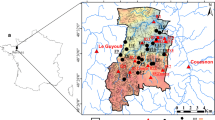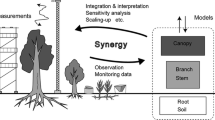Abstract
The KoFlux program is dedicated to understanding the fluxes of energy and matter, water resource management, and net ecosystem production in key ecosystems of Monsoon Asia. Under the framework of AsiaFlux, it is a joint effort with determined, comprehensive international strategies to bring Asia’s key ecosystems under observation. Built upon the augmented KoFlux infrastructure (i.e., Gwangneung supersite), the ‘HydroKorea’ and ‘CarboKorea’ projects pursue new methodologies to assess water and carbon cycles at various temporal, spatial, and process scales. Particularly, the multiscaling approaches are used to link process-level studies, flux footprint, ecohydrological and biogeochemical schemes, and high-resolution satellite images. We hope that the work presented here encourages more ground-breaking studies aimed at bridging the gaps in the cross-scale studies of ecohydrological and biogeochemical cycles in heterogeneous and complex landscapes.




Similar content being viewed by others
References
Baldocchi DD (2003) Assessing the eddy covariance technique for evaluating carbon dioxide exchange rates of ecosystems: past, present and future. Global Change Biol 9:479–492. DOI 10.1046/j.1365–2486.2003.00629.x
Baldocchi DD, Falge E, Gu L, Olson R, Hollinger D, Running S, Anthoni P, Bernhofer C, Davis K, Evans R, Fuentes J, Goldstein A, Katul G, Law B, Lee X, Malhi Y, Meyers T, Munger W, Oechel W, Paw KT, Pilegaard K, Schmid HP, Valentini R, Verma S, Vesala T, Wilson K, Wofsy S (2001a) FLUXNET: a new tool to study the temporal and spatial variability of ecosystem-scale carbon dioxide, water vapor and energy flux densities. Bull Am Meteorol Soc 82:2415–2434
Baldocchi DD, Falge E, Wilson K (2001b) A spectral analysis of biosphere-atmosphere trace gas flux densities and meteorological variables across hour to multi-year time scales. Agric For Meteorol 107:1–27
Blöschl G (1998) Scale and scaling in hydrology—a framework for thinking and analysis. Wiley, Chichester
Bear J (1972) Dynamics of fluids in porous media. Elsevier, New York
Cohen WB, Spies TA, Bradshaw GA (1990) Semivariograms of digital imagery for analysis of conifer canopy structure. Remote Sens Environ 34:167–178
Finnigan J, Clement RJ, Malhi Y, Leuning R, Cleugh H (2003) A re-evaluation of long-term flux measurement techniques Part I: Averaging and coordinate rotation. Boundary Lay Meteorol 107:1–48. DOI 10.1023/A:1021554900225
Foken T, Leclerc MY (2004) Methods and limitations in validation of footprint models. Agric For Meteorol 127:223–234
Grayson R, Blöschl G (2001) Spatial processes, organization and patterns. In: Grayson R, Blöschl G (eds) Spatial patterns in catchment hydrology: observations and modeling. Cambridge University Press, Cambridge, pp 3–16
Harvey LD (2000) Upscaling in global change research. Clim Change 44:225–263
Hipps L, Kustas W (2001) Patterns and organization in evaporation. In: Grayson R, Blöschl G (eds) Spatial patterns in catchment hydrology: observations and modeling. Cambridge University Press, Cambridge, pp 105–122
Hong J, Kim J, Lee D, Lim J (2006) Estimation of the storage and advection effects on H2O and CO2 exchanges in a hilly KoFlux forest catchment. Water Resource Res (in press)
Horst TW, Weil JC (1992) Footprint estimation for a scalar flux measurement in the atmospheric surface layer. Boundary Layer Meteorol 59:279–318. DOI 10.1007/BF00119817
Katul G, Lai CT, Schäfer K, Vidakovic B, Albertson J, Ellsworth D, Oren R (2001) Multiscale analysis of vegetation surface fluxes: from seconds to years. Adv Water Res 24:1119–1132
Kim J, Kim WS, Cho CH, Choi BC, Chung HS, Lee BL, Kim KH, Kim KR, Kim MY, Lee BY, Lee D, Lee GW, Lee JT, Lim JH, Oh JH, Park EW, Shim JS, Yun JI, Rho CS (2002) KoFlux: a new tool to study biosphere-atmosphere interactions in Asia. In: Lee D, Jin V, Son Y, Yoo S, Lee HY, Hong SK, Ihm BS (eds) Ecol of Korea. Bumwoo Publishing Company, Seoul, pp 215–229
Kim J, Guo Q, Baldocchi DD, Leclerc MY, Xu L, Schmid HP (2006) Upscaling fluxes from tower to landscape: Overlaying flux footprints on high-resolution (IKONOS) images of vegetation cover. Agric For Meteorol 136:132–146. DOI 10.1016/j.agrformet.2004.11.015
Koo J, Son Y, Kim R, Kim J (2005) A study on methods of separating soil respiration by source. Kor J Agric For Meteorol 7:28–34
Levesque J, King DJ (1999) Airborne digital camera image semivariance for evaluation of forest structural damage at an acid mine site. Remote Sens Environ 68:112–124. DOI 10.1016/S0034-4257(98)00104-7
Levin SA (1992) The problem of pattern and scale in ecology. Ecol 73:1943–1967
Levin SA (1993) Concepts of scale at the local level. In: Ehleringer JR, Field CB (eds) Scaling physiological processes: leaf to globe. Academic, San Diego, pp 7–19
Lim JH, Shin JH, Jin GZ, Chun JH, Oh JS (2003), Forest stand structure, site characteristics and carbon budget of the Gwangneung natural forest in Korea, Kor J Agric For Meteorol 5:101–109
Mandelbrot BB (1982) The fractal geometry of nature. Freeman, New York
Mohanty BP, Kanwar RS (1997) A relative-flux-correction scheme for analyzing three dimensional data of a tile-drained agricultural plot. J Hydrol 194:107–125. DOI 10.1016/S0022-1694(96)03225-8
Peterson GD (2000) Scaling ecological dynamics: self-organization, hierarchical structure, and ecological resilience. Clim Change 44:291–309
Reynolds JF, Wu J (1999) Do landscape structural and functional units exist? In: Tenhunen JD, Kabat P (eds) Integrating hydrology, ecosystem dynamics, and biogeochemistry in complex landscapes. Wiley, New York, pp 273–296
Skøien JO, Blöschl G, Western AW (2003) Characteristic space scales and timescales in hydrology. Water Resour Res 39(10):1304. DOI 10.1029/2002WR001736
Schmid HP (1997) Experimental design for flux measurements: matching scales of observations and fluxes. Agric For Meteorol 87:179–200. DOI 10.1016/S0168-1923(97)00011-7
Schmid HP (2002) Footprint modeling for vegetation atmosphere exchange studies: a review and perspective. Agric For Meteorol 113:159–183. DOI 10.1016/S0168-1923(02)00107-7
Shugart HH (1996) The importance of structure in understanding global change. In: Walker B, Steffen W (eds) Global change and terrestrial ecosystems. Cambridge University Press, New York, pp 117–126
Suh SU, Chun YM, Chae NY, Kim J, Lim JH, Yokozawa M, Lee MS, Lee JS (2006) A chamber system with automatic opening and closing for continuously measuring soil respiration based on an open-flow dynamic method. Ecol Res 21:405–414. DOI 10.1007/s11284-005-0137-7
Tenhunen JD, Kabat P (1999) Integrating hydrology, ecosystem dynamics, and biogeochemistry in complex landscapes: report of the Dahlem workshop on integrating hydrology, ecosystem dynamics, and biogeochemistry in complex landscapes. Wiley, New York
Vesala T, Rannik Ü, Leclerc MY, Foken T, Sabelfeld K (2004) Flux and concentration footprints. Agric For Meteorol 127:111–116
Wainwright J, Mulligan M (2004) Environmental modelling: finding simplicity in complexity. Wiley, New York
Wood EF, Sivapalan M, Beven KJ, Band L (1988) Effects of spatial variability and scale with implications to hydrologic modeling. J Hydrol 102:29–47. DOI 10.1016/0022-1694(88)90090-X
Wood EF, Sivapalan M, Beven KJ (1990) Similarity and scale in catchment storm response. Rev Geophys 28:1–18
Zhang X, Drake NA, Wainwright J (2004) Scaling issues in environmental modelling. In: Wainwright J, Mulligan M (eds) Environmental modelling: finding simplicity in complexity. Wiley, Chichester, pp 319–334
Acknowledgments
Our special thanks to Korea National Arboretum for their generous supports and encouragement. This work was supported by the Sustainable Water Resources Research Center of Twenty-first Century Frontier Research Program (Grant code: 1-8-2); Eco-Technopia 21 Project of the Ministry of Environment; Research program of Korea Forest Research Institute; and BK21 program of the Ministry of Education and Human Resource Management of Korea.
Author information
Authors and Affiliations
Corresponding author
About this article
Cite this article
Kim, J., Lee, D., Hong, J. et al. HydroKorea and CarboKorea: cross-scale studies of ecohydrology and biogeochemistry in a heterogeneous and complex forest catchment of Korea. Ecol Res 21, 881–889 (2006). https://doi.org/10.1007/s11284-006-0055-3
Received:
Accepted:
Published:
Issue Date:
DOI: https://doi.org/10.1007/s11284-006-0055-3




